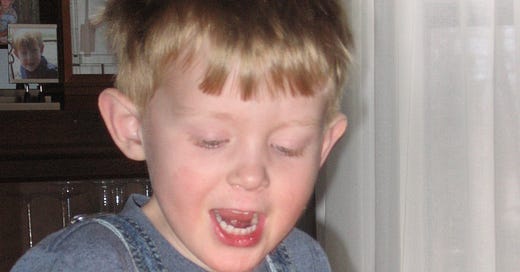This newsletter is part of a series looking back on what we did right and wrong, when raising our son with high functioning autism.
Equipped with tape recorders and notebooks, a team of researchers led by two Kansas psychologists, Betty Hart and Todd Risley, conducted intensive studies of the home life of children in the 1990s. Over two and a half years, they visited the homes of close to four dozen families with young children, starting when the kids were 7 months old. They recorded every word that child’s primary caregiver said to their child during weekly, one-hour sessions.
After transcribing each conversation and then analyzing the exchanges as a whole, the researchers discovered major differences in the number of words spoken in middle-class families and in lower-income ones.
Their landmark study published in 1995 found that a middle class child was exposed to roughly 1,540 more spoken words per hour than a child on welfare. Over time, they concluded, this word gap snowballs so much that by age 4, children in wealthier families were exposed to 32 million more words than children in poorer ones. This “word gap” study was used to explain academic disparities between poor and rich kids, and a huge impact on public policy.
A later study published in 2018 posed serious questions about Hart and Risley’s research methods. I interviewed the lead author of that study, Dough Sperry, for an Atlantic article on this topic. Sperry said that the word gap study failed to accurately record the complex language environment in poor families. Despite Sperry’s concerns about the findings around class and parenting styles, everybody agreed on one thing — a language-rich environment was critically important for child development.
When my son turned two, Ian’s language differences were obvious. He didn’t have enough words, so I was told by friends to have him evaluated by the state’s Early Invention program. After an afternoon of testing, they said that he had a condition called “speech apraxia.” Like a stroke victim, Ian had poor control of his mouth and simply couldn’t get his brain to tell his mouth what to do.
Twice a week, a speech therapist came to the house strapped him into a high chair and did mouth exercises with him. He learned how to blow out candles and chew on straws. She told us that Ian should learn sign language, so we got some videos and all learned the signs for thank you and banana.
The therapist only helped us for two hours per week, so the rest of the week was all me. And in that time, I talked and talked and talked. For two years, I talked to Ian all day long or as much as I could without going insane.
Sometimes I talked to him about a puzzle he was working on and tried to get him to respond “yes or no” to simple questions. If he wanted to play with the trains, I would lie down next to him on the floor and say, "Here comes Thomas. He is going up the hill. He is hitting Percy. Is Percy or James red?"
I offered him options. "Do you want milk or orange juice?" I waited for him to answer before I gave him the thing.
Strapped in the car seat unable to run away, Ian was subjected to questions about traffic safety and transportation: “What color is the light? What does that mean?"
Other times I just babbled while doing ordinary tasks around the house. "I'm cooking green beans. I love green beans. You hate green beans. Jonah hates green beans. Mommy is going crazy."
When we realized that he could read, we pasted words and sentences all over the house. We surrounded the boy with words: verbal words, written words, hand motion words. There were no books or websites that told me what to do. I just figured it out as I went along.
Researchers have shown that rich language environments have a huge developmental impact on typical children. I gave Ian a language-rich environment — a basic element of good parenting — but I did it on steroids. I talked for two years straight with very little response. Then, his speech suddenly made big jumps at around age 4.
One perk of being a long time blogger is that I have records of my life for nearly twenty years, including this two-year verbal marathon. It’s hard for me to read those old posts — I was clearly very concerned about my little boy back then — but I dove into the archives this evening and embedded a few links here to the old blog posts.
Now, I don’t know for sure whether Ian would have made the same progress, if I had just done regular talking with him, rather than steroid talking. Maybe he would have talked no matter what. But given all the research on the benefits of intense interventions on young children, as well as the studies on language-rich environment, I think I stumbled onto the right solution for Ian.
Today, Ian’s speech is good enough for a college computer science class, but not good enough for the Harvard debate team, which is totally acceptable. He still gets some speech therapy, because he never mastered the art of small talk. But that’s okay, too. And guess what? He’s still improving.
LINKS
I wrote about the need for community centers last week on my general newsletter.
Picture: This is Ian blowing out the candles on his birthday cake at age 5. It actually took a lot of therapy for him to have that control over his mouth muscles.




